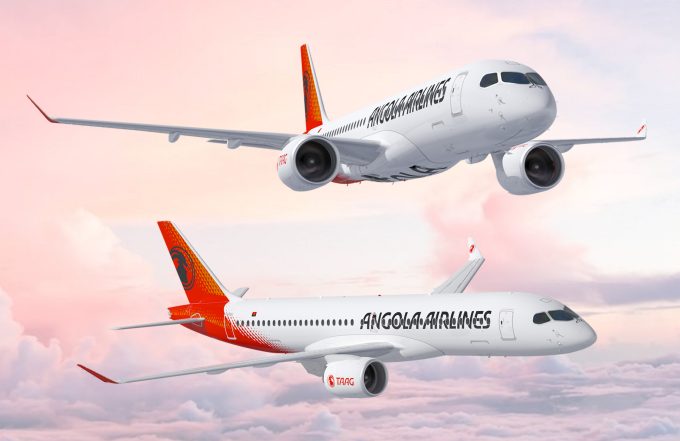Former Polar Air US customer service chief Schirmer jailed for fraud
Polar Air Cargo’s former senior director of customer service for the Americas, Robert Schirmer, has ...
FDX: ABOUT USPS PRIVATISATIONFDX: CCO VIEWFDX: LOWER GUIDANCE FDX: DISRUPTING AIR FREIGHTFDX: FOCUS ON KEY VERTICALFDX: LTL OUTLOOKGXO: NEW LOW LINE: NEW LOW FDX: INDUSTRIAL WOESFDX: HEALTH CHECKFDX: TRADING UPDATEWMT: GREEN WOESFDX: FREIGHT BREAK-UPFDX: WAITING FOR THE SPINHON: BREAK-UP ALLUREDSV: BREACHING SUPPORTVW: BOLT-ON DEALAMZN: TOP PICK
FDX: ABOUT USPS PRIVATISATIONFDX: CCO VIEWFDX: LOWER GUIDANCE FDX: DISRUPTING AIR FREIGHTFDX: FOCUS ON KEY VERTICALFDX: LTL OUTLOOKGXO: NEW LOW LINE: NEW LOW FDX: INDUSTRIAL WOESFDX: HEALTH CHECKFDX: TRADING UPDATEWMT: GREEN WOESFDX: FREIGHT BREAK-UPFDX: WAITING FOR THE SPINHON: BREAK-UP ALLUREDSV: BREACHING SUPPORTVW: BOLT-ON DEALAMZN: TOP PICK

TAAG Angola is pursuing a regional expansion of cargo services, with plans to make Luanda a key hub for air freight sorting in southern Africa.
The airline is keen to exploit new opportunities from the recently opened New Luanda International Airport.
In the past nine months, the airline has opened freighter services to Brazzaville (BZA),Johannesburg (JNB), Lagos (LOS) and Kinshasa (FIH). In July, it announced increased cargo capacity to key markets in Nigeria, Republic of Congo and South Africa.
David Ambridge, director of cargo and Mail at TAAG, told The Loadstar that new destinations were planned for Libreville (LBV), Nairobi (NBO) and Bamako (BKO) from Q4 24 into next year.
“We see a whole range of products coming through, including machine parts, perishables, pharma, fruit and vegetables, computer parts and other items,” he said.
The airline has increased weekly cargo capacity between Luanda and Johannesburg to 100 tonnes and 45 tonnes on the Luanda-Lagos-Brazzaville route. JNB services will increase to five times weekly in quarter four.
TAAG Cargo operates one B737-800BCF aircraft with a 24-tonne cargo capacity, with 11 pallet positions that accommodate 10 contoured 96in x 125in pallets. The remaining capacity is spread across the belly of the passenger fleet: five 777-300s, six 737-700s and six Q400 turboprops.
“We are expecting one more 737-800Fs in 2025 and we will also start deliveries of our four 787s,” said Mr Ambridge. The airline has also placed orders for A220-300s through several lessors.
Cargo is a growing area for TAAG and the New Luanda International Airport. In January, the airline started cargo-only operations from the new facility, with passenger traffic expected to follow shortly.
The cargo terminal at the new airport can handle 130,000 tonnes a year, Mr Ambridge said: “This allows us to grow with without capacity concerns for the next several years. There is also space at the airport for another cargo terminal, so we are well covered for at least the next 20 years.”
Angola has been undergoing economic reforms to improve its business environment, attract foreign investment and boost trade. However, it can be a complex environment, with significant bureaucratic hurdles that can delay or complicate trade processes.
“Customs formalities in this region are not easy,” said Mr Ambridge. “Most shipments are still subject to customs inspection, and this can delay the shipment by several hours, or even a couple of days.”
The industry must lobby African authorities to streamline customs procedures and align them with automated processes that are already used widely in other countries, he said and suggested: “Regional free-trade agreements may go some way in improving this.”
The Angolan government has been working on improving the air cargo sector as it continues to diversify from its oil-dependent economy. Air cargo is seen as an enabler for growth in sectors like manufacturing, retail and agriculture.
Due to Angola’s extensive coastline, sea freight is a strong competitor, especially for bulk goods, but air cargo remains crucial for time-sensitive and high-value shipments.
Angola is still very import-focused; there are only around 20 freight forwarders in the country, so capacity is never an issue, according to Mr Ambridge. “Regional demand is growing, especially to countries like Nigeria and South Africa. TAAG Cargo works on the hub principle, so we are bringing cargo from the region to Luanda and then move it along from here,” he said.
In the future, the airline will consider long-haul cargo operations, but the use of long-haul freighters always requires careful consideration, MrAmbridge noted.
“I think our next move would a B767-300F or A330F, so this moves us from 20-tonne capacity to 60-tonne, and I would want to see that full before considering a further move to a B777F or B747F.”
Comment on this article